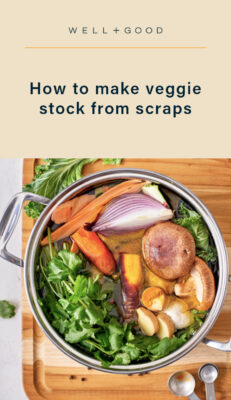4 Mistakes That’ll Make Your Homemade Vegetable Stock Bitter and Bland
Well+Good's Wellness Trends predict the upcycled food movement is only going to continue to grow in 2021. Making your own stock is a great way to practice sustainability in your own kitchen. Yumna Jawad, the blogger behind Feel Good Foodie, says she upcycles everything from potato peels to basil stems by using them to flavor her veggie stock. Pretty much everything goes into that pot, including her peels (from things like potatoes, carrots, and onions), leaves (like on the top of carrots, beets, and celery), and stems (from basil, fennel, and dill). "It adds so much flavor to your food that you'd be surprised," she says.
The process is simple, too. Whenever she has food scraps after making a meal, she stores them in a gallon-sized bag in her freezer. Then once it gets full, she dumps it into a large pot with 3 to 6 cups of water. Not only do all of these different food scraps add flavor, but also a beautiful color for your stock. "I bring it to a boil and then let it simmer for an hour or two. In three or four hours, it's going to make your home smell so good," she says. "Then what you'll do is drain that out, and you can use the stock for up to seven days."
As great as it is to be able to make a delicious veggie stock at home from food scraps, there are some exceptions to the "toss-everything-in-the-pot" rule. "People will ask me, 'What things can you not put in a vegetable stock?' It's a really good question because we want to be mindful of the taste; you're not just going to throw anything and everything in there, although you could throw anything and everything in there," she says. Unfortunately, some scraps can make your stock bitter, completely ruining the flavor. And other ingredients can make your stock bland.

4 things to leave out of your veggie stock
1. Turnips and radishes
While you can toss in the tops of most produce, there are some root veggies she recommends leaving out. "Stay away from some of those really bitter root vegetables, like turnips and radishes," says Jawad. They can ruin the balance of your stock, making it come out very bitter.

{{post.sponsorText}}
2. Cruciferous vegetables
Scraps from cruciferous vegetables—like broccoli and cauliflower—are also going to make your stock taste wonky. "I like to stay away from cruciferous vegetables because they can be really bitter in a stock," says Jawad.
3. Chickpea water
While you can use chickpeas in your stock, leave out the chickpea water. (Instead, you can use it to make fluffy vegan mayo, or as an egg replacement in your recipes.) "I don't recommend the chickpea water, because it could get too gelatinous if it's mixed for a long time," says Jawad. "That texture's going to be too gummy."
4. Un-soaked dried beans
According to Jawad, you also never want to add dried beans right into your veggies stock. Otherwise, you might end up with something bland. "If you're going to use dry beans, I recommend soaking them the day before," she says. "That way, once you add them to the stock, they're already kind of plumped and ready to exert their flavor."
Put your veggie stock to use in this soup recipe:
For more healthy recipes and cooking ideas from our community, join Well+Good’s Cook With Us Facebook group.
Loading More Posts...